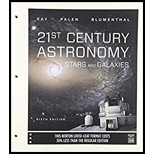
21ST CENTURY ASTR.:STARS..(LL)-PACKAGE
6th Edition
ISBN: 9780393448450
Author: Kay
Publisher: NORTON
expand_more
expand_more
format_list_bulleted
Concept explainers
Question
Chapter 21, Problem 21QP
To determine
Whether the expansion of universe makes Sun, and Milky Way galaxy bigger.
Expert Solution & Answer
Want to see the full answer?
Check out a sample textbook solution
Students have asked these similar questions
A particle with a charge of − 5.20 nC is moving in a uniform magnetic field of (B→=−( 1.22 T )k^. The magnetic force on the particle is measured to be(F→=−( 3.50×10−7 N )i^+( 7.60×10−7 N )j^. Calculate the scalar product v→F→. Work the problem out symbolically first, then plug in numbers after you've simplified the symbolic expression.
Need help wity equilibrium qestion
need answer asap please thanks you
Chapter 21 Solutions
21ST CENTURY ASTR.:STARS..(LL)-PACKAGE
Ch. 21.1 - Prob. 21.1CYUCh. 21.2 - Prob. 21.2CYUCh. 21.3 - Prob. 21.3ACYUCh. 21.3 - Prob. 21.3BCYUCh. 21.4 - Prob. 21.4CYUCh. 21 - Prob. 1QPCh. 21 - Prob. 2QPCh. 21 - Prob. 3QPCh. 21 - Prob. 4QPCh. 21 - Prob. 5QP
Ch. 21 - Prob. 6QPCh. 21 - Prob. 7QPCh. 21 - Prob. 8QPCh. 21 - Prob. 9QPCh. 21 - Prob. 10QPCh. 21 - Prob. 11QPCh. 21 - Prob. 12QPCh. 21 - Prob. 13QPCh. 21 - Prob. 14QPCh. 21 - Prob. 15QPCh. 21 - Prob. 16QPCh. 21 - Prob. 17QPCh. 21 - Prob. 18QPCh. 21 - Prob. 19QPCh. 21 - Prob. 20QPCh. 21 - Prob. 21QPCh. 21 - Prob. 23QPCh. 21 - Prob. 24QPCh. 21 - Prob. 25QPCh. 21 - Prob. 26QPCh. 21 - Prob. 27QPCh. 21 - Prob. 28QPCh. 21 - Prob. 29QPCh. 21 - Prob. 30QPCh. 21 - Prob. 31QPCh. 21 - Prob. 32QPCh. 21 - Prob. 33QPCh. 21 - Prob. 34QPCh. 21 - Prob. 35QPCh. 21 - Prob. 36QPCh. 21 - Prob. 37QPCh. 21 - Prob. 38QPCh. 21 - Prob. 39QPCh. 21 - Prob. 40QPCh. 21 - Prob. 41QPCh. 21 - Prob. 42QPCh. 21 - Prob. 43QPCh. 21 - Prob. 44QPCh. 21 - Prob. 45QP
Knowledge Booster
Learn more about
Need a deep-dive on the concept behind this application? Look no further. Learn more about this topic, physics and related others by exploring similar questions and additional content below.Similar questions
- A man slides two boxes up a slope. The two boxes A and B have a mass of 75 kg and 50 kg, respectively. (a) Draw the free body diagram (FBD) of the two crates. (b) Determine the tension in the cable that the man must exert to cause imminent movement from rest of the two boxes. Static friction coefficient USA = 0.25 HSB = 0.35 Kinetic friction coefficient HkA = 0.20 HkB = 0.25 M₁ = 75 kg MB = 50 kg P 35° Figure 3 B 200arrow_forwardA golf ball is struck with a velocity of 20 m/s at point A as shown below (Figure 4). (a) Determine the distance "d" and the time of flight from A to B; (b) Determine the magnitude and the direction of the speed at which the ball strikes the ground at B. 10° V₁ = 20m/s 35º Figure 4 d Barrow_forwardThe rectangular loop of wire shown in the figure (Figure 1) has a mass of 0.18 g per centimeter of length and is pivoted about side ab on a frictionless axis. The current in the wire is 8.5 A in the direction shown. Find the magnitude of the magnetic field parallel to the y-axis that will cause the loop to swing up until its plane makes an angle of 30.0 ∘ with the yz-plane. Find the direction of the magnetic field parallel to the y-axis that will cause the loop to swing up until its plane makes an angle of 30.0 ∘ with the yz-plane.arrow_forward
- A particle with a charge of − 5.20 nC is moving in a uniform magnetic field of (B→=−( 1.22 T )k^. The magnetic force on the particle is measured to be (F→=−( 3.50×10−7 N )i^+( 7.60×10−7 N )j^. Calculate the y and z component of the velocity of the particle.arrow_forwardneed answer asap please thank youarrow_forward3. a. Determine the potential difference between points A and B. b. Why does point A have a higher potential energy? Q = +1.0 C 3.2 cm 4.8 cm Aarrow_forward
arrow_back_ios
SEE MORE QUESTIONS
arrow_forward_ios
Recommended textbooks for you
 Foundations of Astronomy (MindTap Course List)PhysicsISBN:9781337399920Author:Michael A. Seeds, Dana BackmanPublisher:Cengage Learning
Foundations of Astronomy (MindTap Course List)PhysicsISBN:9781337399920Author:Michael A. Seeds, Dana BackmanPublisher:Cengage Learning Stars and Galaxies (MindTap Course List)PhysicsISBN:9781337399944Author:Michael A. SeedsPublisher:Cengage Learning
Stars and Galaxies (MindTap Course List)PhysicsISBN:9781337399944Author:Michael A. SeedsPublisher:Cengage Learning An Introduction to Physical SciencePhysicsISBN:9781305079137Author:James Shipman, Jerry D. Wilson, Charles A. Higgins, Omar TorresPublisher:Cengage Learning
An Introduction to Physical SciencePhysicsISBN:9781305079137Author:James Shipman, Jerry D. Wilson, Charles A. Higgins, Omar TorresPublisher:Cengage Learning AstronomyPhysicsISBN:9781938168284Author:Andrew Fraknoi; David Morrison; Sidney C. WolffPublisher:OpenStax
AstronomyPhysicsISBN:9781938168284Author:Andrew Fraknoi; David Morrison; Sidney C. WolffPublisher:OpenStax Stars and GalaxiesPhysicsISBN:9781305120785Author:Michael A. Seeds, Dana BackmanPublisher:Cengage Learning
Stars and GalaxiesPhysicsISBN:9781305120785Author:Michael A. Seeds, Dana BackmanPublisher:Cengage Learning

Foundations of Astronomy (MindTap Course List)
Physics
ISBN:9781337399920
Author:Michael A. Seeds, Dana Backman
Publisher:Cengage Learning

Stars and Galaxies (MindTap Course List)
Physics
ISBN:9781337399944
Author:Michael A. Seeds
Publisher:Cengage Learning

An Introduction to Physical Science
Physics
ISBN:9781305079137
Author:James Shipman, Jerry D. Wilson, Charles A. Higgins, Omar Torres
Publisher:Cengage Learning

Astronomy
Physics
ISBN:9781938168284
Author:Andrew Fraknoi; David Morrison; Sidney C. Wolff
Publisher:OpenStax

Stars and Galaxies
Physics
ISBN:9781305120785
Author:Michael A. Seeds, Dana Backman
Publisher:Cengage Learning

General Relativity: The Curvature of Spacetime; Author: Professor Dave Explains;https://www.youtube.com/watch?v=R7V3koyL7Mc;License: Standard YouTube License, CC-BY